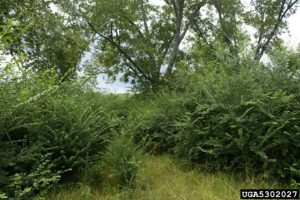
Shannon Kennedy, ANR Educator, UGA Extension Forsyth County
We’re all familiar with the vista that kudzu creates: a blanket of green consuming trees, fields, and buildings. Similarly, the sight of dense thickets of Chinese privet that squeeze out any other type of undergrowth is common in forests, parks, and neighborhoods. These are poster children for non-native invasive species in the Southeast, but they’re not the only invasive threats we face. To reduce the impact of non-native invasive plants, we need to know what they are, how to identify them, and what control methods to use. The vocabulary surrounding invasive species can be confusing. An invasive species is a plant, insect, or animal that causes harm to people, the economy, or the environment. Note that this definition does not address the region the invasive plant originated from. A plant can be a native species and be invasive if it spreads prolifically somewhere it is not wanted. However, usually when people discuss “invasive species,” they usually mean a non-native, introduced species; something that is not from our area and causes environmental or economic damage.

Non-native plants become invasive because they have advantage over native plants for living in our environment. Some invasive plants have an extended growing season, some produce hundreds of thousands of seeds, and others simply grow faster than other plants. Many of these plants thrive in disturbed habitat, so developing areas and tilled fields provide opportunities for these organisms to become established. They rapidly spread, overtaking any other plants that may be trying to grow, reducing biodiversity, and possibly threatening human, livestock, or crop health.
Since different species cause different types of damage, it can be hard to decide which species is the worst. Do you classify them by their prevalence? Is a poisonous plant worse than a vine that carries a crop disease? In 2019 the Forestry Commission released the “dirty dozen” invasive plant list based on the acres of land covered. From lowest to highest ranking, those species are: Chinese wisteria, trifoliate orange, mimosa, English ivy, non-native olives, Japanese climbing fern, Chinese tallowtree, kudzu, non-native lespedeza, chinaberry, Japanese stiltgrass, and taking first place: Chinese privet. In addition to this, Forsyth County has its fair share of Japanese honeysuckle, golden bamboo, and princesstrees.
So, what can we do about these invasive plants? Since Georgia law does not restrict the sale of potentially invasive plants, plant retailers market English ivy, Bradford pears, periwinkles, and nandina. By finding a substitute, possibly native, plant to use, we can avoid spreading invasive plants from our landscapes. Check out the blooming and fruiting selections in the Forsyth County Extension Fall Plant Sale.
The next step is to become familiar with non-native invasives so we can remove them if they are in our landscape. Some plants, like young Japanese stiltgrass (also known as Nepalese browntop) are easy to pull up. Hand weeding these annual plants before they mature enough to produce seeds is very effective in reducing their numbers in the current and subsequent years. Other invasive plants have woody stems and waxy leaves, so pulling and spraying herbicides does not work well. For woodier plants, it’s usually more effective to cut the stem of the plant and immediately apply a stump herbicide so the chemical can travel into the root system. This prevents resprouting or growth.
One excellent resource for learning about invasive species in Georgia is Invasive.org. The website has profiles of all invasive organisms as well as news surrounding invasive species issues. For a more active role, download the EDDMapS app. This invasive species tracking effort is supported by the University of Georgia’s Center for Invasive Species and Ecosystem Health, and it is a place where concerned people can report the location of invasive species. The data helps researchers track the abundance and spread of different invasive species. Invasive plants are a widespread problem that require a team effort, such as the Cogongrass Eradication Team, to resolve. Since 2004, landowners have worked in concert with the Georgia Forestry Commission to scout, report, and take action to eradicate this plant. Locally, the Forsyth County Commission recently approved an ordinance amendment to allow communities and landowners to work with the county arborist to control and eradicate invasive plants in buffer zones.